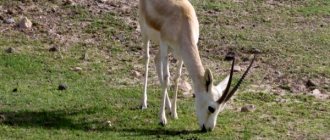Name: Common, South Russian and small-eyed mole rat Lat.:
Spalax microphthalmusClass: Mammals - Mammalia Order: Rodents - Rodentia Family: Mole rats - Spalacidae
| Habitats: | garden |
| Dangerous for: | roots, bulbs and rhizomes |
| Description: | A year-round active animal with a big appetite. |
Description and features
The mole rat belongs to the category of rodents. In the process of evolution, he completely adapted to life underground, which affected his appearance:
- it has a small body, up to 32 cm long;
- the weight of the animal can reach 1 kg;
- ears are missing;
- the paws and tail are short, therefore practically invisible;
- the body is covered with soft dark fur;
- the eyes atrophied and lost the ability to see. Due to the folds of the skin, they became completely invisible.
The mole rat in the photo looks like a mysterious and shy creature.
Harm in the garden
The appearance of a rodent in a garden or summer cottage is a real problem. This creature can deprive you of your potato, carrot and beet harvest. A logical question arises - how to get rid of the voracious mole rat in the country house or garden. It eats plant tops and stores root crops for the winter. One adult can ruin the work of an entire summer season. More than 10 kg of root crops were found in the burrows, and the rodent is satisfied with more than one vegetable storehouse. The more well-groomed the garden, the greater the desire of these animals to settle on it.
What is the difference between a mole rat and a mole?
Some people mistakenly confuse these rodents with moles, but they are completely different animals. There are two main differences between them:
- The mole rat is much larger.
- The mole builds its tunnels with the help of its paws, but the second one has them poorly developed and has small claws, so it carries out construction work thanks to its front incisors.
- Moles feed on insects, and mole rats prefer roots and plant stems.
Lifestyle
Leads an underground lifestyle, practically never rising to the surface. Sets up a complex two-level system of burrows. Looks for food at the top, lives below and stores supplies for the winter. The depth of occurrence in winter can reach 3 meters. This helps to determine the place where the animal’s main housing is located: there is clay in the soil excavated to the surface.
It digs its passages with its front incisors, raking the earth under itself, then turns around and pushes the soil out with its head like a shovel. When the earth becomes too far away, it arranges a new exit to the surface. Active mainly at night. During the day, all residential passages are clogged with earth. It does not arrange storage facilities for supplies, using dug passages for this purpose.
These animals are loners, and when they meet uninvited guests on their territory, they start real fights among themselves. They live in families, including a male and a pair of females. Family groups are very stable and disintegrate only if one of the animals dies.
Kinds
In nature, there are several species of rodents that differ in color, size and place of residence:
- The common or South Russian mole rat has a gray-brown color. It belongs to the most common species. Lives on the territory of Moldova, Ukraine, Russia. Its soft skin is beginning to be used for making fur coats, but not in large quantities, which is why the common mole rat is not yet listed in the Red Book as an endangered species. It is also characterized by a stable population, thanks to which the number of these animals is maintained.
- The giant mole rat is the largest representative, weighing up to a kilogram. It has a light gray or brown coat color. Older individuals have white spots on the head and body. This species is characterized by poor reproduction, which is why it is included in the Red Book of Russia and the International List of Nature Conservation.
- The sandy representative is similar in appearance to its giant relative. Prefers to live in the forest-steppe and near the Dnieper. The rodent is also under protection.
- The Podolsk species is relatively small in size. It is on the verge of extinction and is therefore considered an endangered species.
- The white-toothed is the smallest rodent, whose length barely reaches 20 cm. Its characteristic dark brown color. The mole rat lives in Turkey, Ukraine, Moldova, Romania, Bulgaria, and Greece.
- The Bukovinian representative is slightly different from other species in the shape of its head. This species is found in European countries.
Natural enemies of giant mole rats
Photo: Giant mole rat
Secretive animals leading an underground lifestyle have almost no enemies in nature. Young animals are most often attacked during relocation. They can be hunted by foxes, large birds of prey, and animals of the mustelid family.
Interesting fact: A mole rat that accidentally finds itself on the surface of the earth first freezes, apparently trying to orient itself, and then begins to spin around in place, backing away, after which it tries to burrow underground as quickly as possible.
Those passages and holes that the rodents left are occupied by predatory animals: bandages, weasels, light and black ferrets.
Interesting fact: In autumn, the light-colored ferret often starts hunting for mole rats. Through unclosed feeding holes, it penetrates into the labyrinth of passages, moves along them, finds the owner and kills, eats the prey, and occupies the hole. At other times of the year, this predator feeds on voles, gophers, and mice.
The sections of feeding passages that are not used by the blind digger are inhabited by gophers, voles, and hamsters.
Human agricultural activities and plowing of meadows and steppes cause harm to mole rats. But since this species often lives in semi-desert areas that are not promising for agriculture, in these regions there is no danger of extermination of rodents by humans. The animal can be hunted by burrowing dogs, and young migrating rodents by cats.
In gardens, people use various methods of scaring away these animals, as well as traps and snares. But since rodents do not come to the surface, this kind of trapping is not effective. The best way is vibration and ultrasonic repellers.
Lifestyle and habitat
The family of rodents, depending on their habitat, is divided into 4 species, which prefer to live in the desert, forest-steppe, steppe and on the outskirts of forests. They are widespread in Europe, Asia, and Africa. Animals spend almost their entire lives underground. There they set up entire labyrinths, where they feel very comfortable.
An interesting fact is that fleas that parasitize rodents have also evolved and lost their vision. Soils of moderate density are suitable for mole rats. They avoid clay and sandy soil. Rodents choose pastures that have lush vegetation. are often found in the garden .
Features of housing construction
Animals dig out their burrows with their teeth. Even the head is involved in the construction of the labyrinth. The animal bites into the soil with its front teeth and pushes out excess soil from its home using its spade-shaped head. The lower jaw is also adapted for construction work. Thanks to the muscles, the incisors can move.
Due to the construction of the tunnel, the front teeth are ground down, but they quickly grow back, so the construction is even useful for the underground dweller. Individuals who live in captivity suffer greatly due to overgrown incisors. Because of them, mole rats cannot close their mouths.
The animal’s nose is also adapted for construction work. It is covered with keratinized skin, which protects it from mechanical injury when tearing up the ground. On one hectare you can find from 2 to 10 individuals. The animals actively build labyrinths in the spring, and from the summer they lead a more passive lifestyle. The underground dweller does not go into hibernation.
The warm-blooded mole rat builds its housing in several tiers:
- First comes the block, which is located at a depth of 20-30 cm. It is called the food block. The animal stores food reserves in it.
- The second block is located at a depth of about 4 meters. It contains a storage room, summer and winter nests.
In winter, the labyrinth is closed with earth and does not open until spring. One tunnel covers an area of up to 450 m. It contains about 10 storage rooms. If there is a lot of earth on the surface, the animal breaks out a new exit. It is always closed during the daytime. The animal becomes active at night and in the afternoon.
Underground inhabitants lead a solitary lifestyle. They diligently protect their territory from other individuals. In the event of an invasion, clashes occur between males, which can result in the death of one of them.
Where does the giant mole rat live?
Photo: Giant mole rat Red Book
The distribution area of this endemic rodent with an underground lifestyle is small.
It is found:
- in semi-desert areas in the northeast of Ciscaucasia;
- in the interval of the lower reaches of the Terek and Kuma rivers;
- in the lower reaches of Sulak;
- south of Makhachkala to Gudermes.
Its settlements reach to the north:
- to the southern lands of the Astrakhan region;
- south of Kalmykia.
There are small and isolated settlements:
- in the east of the Ural River;
- in the Kara-Agach area;
- in the vicinity of the rivers Temir, Emba, Wil;
- in the northeast of the Guryev region;
- in the west of the Atyubinsk region.
The animal prefers sandy and clayey semi-deserts, but settles in places where there is moisture: in river floodplains, in bearded vulture and lake feather grass steppes and forest plantations, and is also found in forest-steppes. Loves chestnut soils. The animal can be seen at an altitude of 1400-2400 m above sea level. m., more often at an altitude of 1500-1600 m.
Interesting fact: Observations of a mole rat released in an area where there were no other individuals showed that in four months it built 284 piles.
Where a group of individuals lives, about 15% of the area is covered with piles of earth. In the spring, mole rats begin to create new feeding passages, which they use throughout the summer. Moving along them, the rodent grabs the sprouting roots, and drags the entire plant behind them. In the fall, they again begin to actively dig tunnels, but this work from above is not so noticeable. The animals expand the passages of the lower tier, the nesting chambers, but do not push the soil out, but clog the feeding passages with them.
Rodents also make seasonal movements. In winter they move closer to forest belts. There is more snow, the ground is protected from the cold and does not freeze as much, and the dense root system is a source of food. In spring they move closer to fields with perennial grasses.
Interesting fact: Mole rats dig holes in sandy soil at a speed of approximately 2.5 cm/hour or 850 mm per 20 minutes, during which time the volume of emissions is 25,000 cm3.
Reproduction and lifespan
Mole rats live from 2 to 9 years. Life expectancy depends on their living conditions. The number of animals is negatively affected by loosening the soil, drought and excessive moisture. Mole rats have few natural enemies, since they spend almost their entire lives underground. They are hunted only by the steppe polecat, which penetrates into their home. When young animals settle on the surface, they can become prey for a fox or a bird of prey.
Despite their solitary lifestyle, during the breeding season rodents form families, which consist of a male and two females. Individuals that live in the neighborhood converge with each other. The male makes a passage underground to the female, who during the mating season creates certain sounds, inviting him to her.
In such a family, cubs appear one after the other. One female gives birth in the first year, and the other in the second. Between February and May, 2-3 babies are born. A newborn is born without fur and its weight reaches only 5 grams, but the baby grows quickly.
When the young animals turn one year old, the cubs are settled into tiers - the girls move to the top, and the boys remain on the bottom. When they turn 3 years old, they are considered adults and begin an independent life.
The mole rat, a secretive pest of gardens and vegetable gardens
12/07/2020 Most gardeners and gardeners in the process of their work have to deal with problems associated with the vital activity of various pest animals. These ubiquitous representatives of our fauna either completely destroy cultivated plants by feeding on them, or significantly reduce their productivity, constantly causing damage to the plant organism, or they spoil or eat some part of the finished crop of root crops. And in all cases, the owner of the site suffers losses, often considerable. And on an industrial scale, the entire industry suffers from such activities.
One of the most secretive and difficult to exterminate mammals that harm agriculture is the mole rat. This rodent is a real disaster not only for small plots of land, but also for large fields. Losses from an overly multiplied population of mole rats can be so significant that in the old days they were even given a monetary reward for their extermination. Some local craftsmen caught hundreds of them during the warm season and received significant additional income from such fishing.
It is difficult to fight a mole rat, so for greater success of this venture it will be useful to first get acquainted with its lifestyle and habits.
In common parlance, people more often call mole rats moles because of the similarity in the lifestyle of these animals, although in fact they are different zoological species belonging to different orders and families: the mole (on the left in the photo below) belongs to the order of insectivores, the Mole family, and mole rat (on the right in the photo) - to the order of rodents, the mole rat family.
Moles and mole rats differ even in appearance. The mole has an oval body, a small wedge-shaped head with a sensitive proboscis nose and small sharp teeth, a short neck, disproportionately large forelimbs with five powerful claws for digging the ground. Moles are smaller than mole rats, their sizes range from 5 to 20 cm in length, and the weight of the largest representatives does not exceed 200 grams. The mole has eyes, although they do not function due to the fact that the retina and lens are not developed. The fur is usually black with various shades, but albino moles are also occasionally found.
The mole digs its underground passages with its front paws, without using its teeth. A mole is a predator that feeds on worms and insect larvae that fall into the lumen of its burrow. At the same time, it does not cause direct harm to agriculture, on the contrary: by eating the larvae of the cockchafer, mole crickets, slugs and other small pests, it is rather an involuntary assistant to humans.
The mole rat looks more like a well-fed rat or a muscular gopher. There are several species of mole rats in nature, but the most common is the common mole rat. This is what we are talking about now. The body of this animal is narrow and long, the legs are relatively thin and short. Adults grow to 30–32 cm in length and can weigh around 700 grams. The mole rat's head is wide and shaped like a bayonet shovel. There are no eyes or ears, and the tail is very short. The fur color is usually brown with a yellow or gray tint.
The main tool with which the mole rat makes its tunnels in the ground is the 4 front incisor teeth. They are even separated from the oral cavity by skin so that soil particles cannot enter the digestive system. The process of digging a hole looks like this: with its incisors the animal gnaws the ground, which immediately crumbles down, after which the mole rat rakes it under itself with its front paws, and pushes it further into the already formed tunnel with its hind paws. When a significant amount of loose earth accumulates behind, the owner of the hole pushes it with his forehead to the surface along a vertical passage made especially for this purpose. As a result of this method of digging passages, characteristic piles of earth appear on the field - molehills
. They clearly indicate the presence of a mole rat on the site.
Mole rats build a hole in several tiers, where the upper passages are intended for obtaining food, and the lower ones are used as a shelter, nest and storerooms. The total length of the labyrinths of one adult mole rat can be from 250 to 3000 meters and depends on many factors: its age (the longer the animal lives in its territory, the more branched the burrow becomes), on the abundance or lack of food in a given area (the scarcer the food resources territory, the more the mole rat has to dig), on the area of the occupied territory (up to 20 individuals can live on 1 hectare; the more densely populated the area, the shorter the burrows of each of them will be) and the density of the soil.
Mole rats are pure vegetarians, preferring to feed on the underground parts of wild and cultivated plants or the plants themselves, pulling them into a hole by the root. Since the nutritional value of food (especially wild food) is quite low, and the animal spends a lot of energy, the mole rat is forced to eat approximately the same amount of vegetation per day as it weighs. Moreover, in addition to daily consumption of the necessary diet, animals also store plant products for future use, which causes even greater harm to crop production. In the storerooms of one mole rat (each individual has several of them) it was possible to find a total of up to 50 kg of potato tubers!
The lifespan of this rodent ranges from 2 to 4.5 years, but occasionally there are individuals of much older age - up to 9 years. Mole rats are more active in the evening and at night. They do not hibernate in winter, but their vital activity during this period is significantly reduced compared to the warm season.
Natural enemies of the mole rat are ferrets, snakes, birds of prey and foxes. Snakes and ferrets can hunt mole rats both in their own burrows and on the surface, and foxes and birds can hunt on the surface of the earth, during the annual migrations of young animals to new territory.
All mole rats are solitary animals that form a union only for the purpose of reproduction. They create pairs only during the short-term mating season. At other times, mole rats actively defend the territory they occupy from their relatives, regardless of the sex and age of the competitor. But, at the same time, the burrows of females and males can communicate or be located very close to each other. Usually one or two females live near the male’s hole, with whom he, as a rule, does not intersect during the non-mating season. When two males meet, a fight is inevitable, and if one of the rivals does not retreat, the skirmish may end in the death of one or even both participants.
Mole rats breed seasonally. At the end of winter or spring (from late February to May), the female gives birth to one to three cubs. The young are born absolutely helpless, but quickly grow and develop. After a few months, young animals become completely independent and can leave the parental hole. From the end of May to autumn, the grown cubs look for their own territory, making transitions on the surface of the earth or underground. Young females usually leave their mother's burrow in the year of birth, moving along the surface, while young males spend the winter in their mother's burrow and leave in the second year of life, often via underground routes.
The younger generation migrates to nearby territories, located from several tens to several hundred meters from their place of birth. It is during this period that the greatest mortality of young animals as a result of attacks by predators is observed. The overall survival rate of offspring is about 50%.
Young females begin to reproduce at the age of one year (already in the next breeding season), and young males - at the age of one and a half to two years, after moving away from the mother.
In addition to direct damage to the crop, mole rats also cause other, indirect damage - their molehills interfere with haymaking and spoil dirt roads.
Fighting this pest is not easy and often ineffective. But there are still ways to get rid of a mole rat on your property, especially if it is still alone and has appeared recently. Right away, ahead of the indignation of animal rights activists about the inhumanity of this idea, I will say that you don’t have to fight the mentioned pest, but then you will have to completely give up the opportunity to grow something on your plot of land, since very soon the mole rats will multiply, and there will be them in your garden a whole colony will live. And also, given that animals will not limit themselves to just your garden, you cannot avoid complications in relations with neighbors.
For those who nevertheless accepted the challenge and decided to fight the mole rat, I can offer several options for effective means, some of which I had to use myself. My struggle began when a mole rat settled in my garden this spring. At first I simply fell into its passages by 20–30 centimeters, but I only noticed the problem at the end of May, when whole rows of potatoes did not come up! (You can see it in the photo). I dug into the ground and found even holes, clearly in a row! I started trying to figure out the problem and gained some experience over the summer.
Measures to combat mole rats can be divided into repellent
and
destroying
.
You can scare away the animal with unpleasant odors, sounds and vibrations. A small homemade weather vane with an impeller can serve as a simple vibration repeller. The principle of operation of such a device is simple: the wind rotates the impeller and, thereby, creates noise and vibration, which is transmitted to the soil through a support post (a pole driven into the ground). The vibration frightens the animal and, according to the plan, mole rats should avoid this area. But from my experience I can say that the idea does not live up to expectations. (By the way, I recently saw molehills in a field located near a highway, where the level of noise and vibration reaches significant levels!)
There is a more technologically advanced way: to repel pests with ultrasound and electromagnetic waves. I haven’t tried it myself, but judging by the reviews, this method also cannot be called effective. Plastic bottles humming in the wind and placed in mole rat burrows also turned out to be useless.
Some sources claim that these underground pests can be kept away from your garden by using plants such as elderberries, blackroot, parsnips, mint, wormwood and other crops with a strong odor. Maybe these smells are unpleasant for rodents, but certainly not to such an extent as to force them to leave their cozy home and go into the unknown. In any case, I was not able to drive away the mole rat with their help.
More reliable are radical methods of control - extermination of mole rats by chemical and mechanical means. Chemicals include regular poisons for rodents or specialized ones developed specifically for these pests. These drugs are certainly effective, but only on condition that the mole rat eats them. In practice, this does not always happen. An animal may simply not notice the baits placed by a person and pass by. Or you can notice the bait, but refuse them, preferring to make do with your usual food supply (potatoes, bulbs and roots of cultivated plants).
Gaseous chemicals deserve special attention. Attempts to poison a mole rat with car exhaust gases or household gas from a cylinder can be dangerous for the person himself and in most cases are not successful. Most likely, having smelled an unpleasant smell, the inhabitant of the hole plugs this part of the labyrinth with a dense earthen plug and moves away from danger, into a clean part of his home.
I tried using a special sulfur bomb. He lit it and put it in the hole, immediately covering it with a sheet of slate and sprinkling it with earth to seal it. Burning slowly, the bomb releases a toxic substance (sulfur dioxide), which irritates the mucous membranes of the respiratory tract and can cause the death of the animal if it inhales this acrid smoke for a long time. For some time, the activity of the animal actually decreased, but after about a week, molehills began to appear on the site again.
The drug “Keeper Fumigant” can help get rid of unwanted underground inhabitants. It consists of tablets that, after opening the package, begin to react with air moisture and within 14 days release poisonous phosphine gas. This compound, entering the lungs of the animal, disrupts gas exchange there and causes the death of the pest.
If a mole rat appeared in your garden recently (a few days ago) and has not yet had time to build an overly branched labyrinth, then it is likely that you may be able to drive it out of its hole with water. This method of control is not suitable for a long-established pest.
The most effective methods of controlling mole rats are mechanical traps. The simplest and most effective (in my opinion) way to catch this rodent is to open its hole and place treble fishing hooks in it. The tackle consists of a flexible steel wire up to 1 meter long, on which 2-3 hooks are attached every 15–20 cm from each other. The free end of the wire should be securely fixed to a metal pin driven into the ground. The mole rat, sensing an influx of fresh air, will hasten to close its hole and will inevitably catch on to one of the “anchors.” All a person can do is get the hooked animal out of the ground and get rid of it.
Another, no less effective method is tunnel traps in the form of a pipe. The tackle is a hollow tube 30–35 cm long, the diameter of which coincides with the diameter of the hole. The tube has flaps at both ends that open only inward. This structure needs to be installed in the opening of the hole and left for several days. While passing through its lands, the mole rat will definitely enter the trap tube. And once inside, he will no longer be able to get out.
Crossbow traps have proven themselves well. The mechanism is a frame with a tight spring attached to it, to the free end of which a sharp steel knitting needle is attached. The trap guard holds the spring in a compressed position. Having excavated a hole in a hole or burrow, the trap should be placed above it, and the guard should be installed in this hole. The animal, sensing that its hole is open, will try to close it and knock down the guard, which will no longer restrain the spring, and it will instantly plunge the needle into the animal. The difficulty of installation is to correctly calculate the distance at which you need to place the trap frame from the entrance to the hole.
There are other methods of struggle. Human imagination is limitless, so you can always choose the method that is most convenient for you. Happy hunting!
All questions of interest on the topic of this article can be discussed on our forum.
Vitaly Chuguevets
Share on social networks:
Harm of mole rats to humans
There is a difficult relationship between rodents and people. Animals cause great damage to summer cottages and cause colossal losses to farmers. One animal can destroy an entire season's harvest. He makes large stocks in his pantries, stealing vegetables from summer residents and farmers. In a day, the pest is able to drag away 6 bushes of root crops.
Excavated underground labyrinths also cause a lot of trouble. A summer cottage with heaps of earth piled up is not a very attractive sight. If you step on an underground passage, you can easily fall into it up to your ankles. The inconvenience of tunnels is also felt on field roads, which the animal mole rat also does not avoid.
Feeding features of the mole rat
Mole rats in nature photo
Mole rats feed mainly on underground parts of plants: roots, rhizomes, bulbs and tubers. They also eat the above-ground parts of plants, which they drag into the burrow by the root.
Among the food plants that mole rats eat, Compositae, umbelliferous and legume crops predominate. For the winter, the animal makes large reserves (more than 10 kg).
Methods of pest control
In the fight against mole rats, poisons that are intended for baiting rats and moles, traps, traps and cats are actively used. The use of poison remains the most effective method in the fight against rodents.
Chemicals must be used with great care. After all, they can also attract curious or hungry pets. It is also necessary to take into account the degree of toxicity of the substance used, because it can get into the soil and cause harm to the owner.
The following pesticides are very popular among farmers:
- "Brodifan" is available in liquid form. They impregnate the bait; 1 kg will require 20 g of Brodifan. On the 4th day after consuming the poison, mole rats will begin to experience attacks of suffocation. They can come to the surface and die over time.
- “Testox” is produced in the form of red briquettes, weighing 10 g. They have a pleasant aroma of peanuts, sunflowers, vanilla and cheese. Its action is similar to the drug Brodifan. On the 4th day, the animals experience attacks of suffocation, and on the 6th day they die due to paralysis of the respiratory system.
- The drug "Storm" is considered one of the most effective. It was developed by the German company BASF. The substance is produced in the form of blue briquettes. “Storm” has a strong aroma that will definitely attract pests.
How do common mole rats live?
An ordinary mole rat, in short, spends its entire life, which is an average of 2.5-4 years, underground, digging complex tunnel systems and obtaining food. Most of all, the animal loves the roots, tubers and bulbs of plants, but it can also feast on stems and leaves. About 10 kg of food supplies must be prepared for the mole rat for the winter. At this time of year, its vital activity noticeably decreases, but the rodent does not hibernate.
The optimal population density of the common mole rat is 3 individuals per hectare, but this number can reach up to 20. With the help of sharp incisors and paws, the animals dig through a branched two-tier system of burrows. The upper tier lies at a depth of 20-25 cm, and the lower one, where the mole rat forms galleries for nesting and storing food supplies, is at a depth of 3-4 m. The external holes are not permanent, but are formed only in order to bring dug up earth to the surface .
Is it worth using traps?
Mole rats have excellent intelligence, thanks to which they deftly avoid traps and various kinds of traps. Elderly individuals sense danger especially well. It is almost impossible to lure them into a trap.
The situation is further complicated by the fact that the animals live deep underground, where it is simply impossible to reach with a trap. In any case, you need to try and use some cunning. Suddenly the underground dweller loses his vigilance and falls into a trap.
To set a trap, you need to find a tunnel dug by the rodent and dig a hole in it, at least 1 meter deep. The mole mole does not like drafts, so it will crawl out of the hole to seal the passage, and this is where the installed trap comes in handy, which needs to be covered with plywood on top for camouflage.
The rodent has a good sense of human odor, so you need to wear gloves when setting the trap. All parts of the structure should be treated with onions, which with their pungent aroma will cover the human smell.
Animal pest
Branched underground labyrinths are perfect for the life of mole rats, but can cause anxiety for humans. If a garden or personal plot becomes the habitat of this rodent, you can say goodbye to the lion's share of the harvest. Most likely, the animal will like carrots, potatoes and onions. He may also like onion flowers, legumes, corn and young trees.
Endless piles of dug up earth, subsidence of the soil, sudden disappearance of planted crops and even small trees - this is what people observe when a common mole rat settles on their plot of land. The description of his sabotage can be continued for a long time, and stopping them is an impossible task for many.
Repellent methods of control
Animal lovers who feel sorry for destroying mole rats can use repellents. Although they will not destroy the enemy, they can force them to leave the area. Pests have a good sense of smell, so you can throw a piece of fabric soaked in kerosene or diesel fuel into their hole. The underground inhabitants will perceive them as a threat and leave the area.
Mole rats cannot tolerate the smell of wormwood, elderberry, mint, medicinal blackroot and imperial hazel grouse, the unpleasant aroma of which comes from the bulb itself. If you plant such plants on a site, you can hope that the rodent will bypass it. Mole rats do not like excessive noise, so you can make your own repeller that will help drive them out:
- A piece of reinforcement is driven into the ground so that 40 cm remains above the surface.
- They put an empty metal can on it and wait for windy weather.
- From the gusts, the bank will begin to hit the reinforcement, and an unpleasant noise will spread underground.
Special devices that emit ultrasound are effective in pest control. When buying such a device, you need to pay attention to the following points:
- Radius of action. It will not be possible to save the site with the help of one device. You need to immediately purchase several ultrasonic emitters.
- Availability of settings. It must be possible to change frequencies. Otherwise, rodents will get used to them and stop avoiding the area.
The advantage of such equipment is that it repels other pests. The site will remain under reliable security.
Measures to combat mole rats
Measures to combat mole rats coincide with measures to combat moles. However, as in the second case, they are often ineffective and require persistence.
In particular, repeated deep digging of the soil, which destroys the feeding systems of their passages, helps get rid of pests. Repelling with unpleasant odors. Using commercial repellers.
You can also catch a mole rat by hand. To do this, you need to identify a freshly dug hole, find another entrance and excavate it. The animal cannot stand drafts and therefore, most likely, will try to fix the destroyed passage, at which point it will be possible to catch it.
They drive the animal out of the hole with the help of water. To do this, they find a mole rat mound of earth mixed with clay, this is the entrance to a hole with a nest, and fill it.
Some sources contain recommendations for the use of traps, but those who have encountered the animal claim that the mole rat somehow recognizes them and deftly avoids them.
House hunters
Hunting breeds of dogs that are accustomed to attacking underground can help in exterminating mole rats. Dachshunds and spaniels are well suited for such purposes. If a cat catches rats, it can also be taught to hunt mole rats. Especially when we are talking about a cat mother who is ready to do anything to protect her babies.
To lure out the pest, you need to dig up its labyrinth, at least a meter deep, and dig another hole about 40 centimeters near the exit. When the rodent appears to bury the failed exit, a cat is seated in the prepared hole, which will show its hunting abilities. As you can see, there are many methods to combat mole rats. Some of them are humane, while others are cruel.
With their help, you can destroy pests or ensure that they leave the area. Considering that they have poorly developed limbs, the animals will not go far, but will simply move to their neighbors. On the one hand, rodents cause great damage to garden plots, and on the other hand, they are listed in the Red Book. Therefore, how to get rid of a mole rat , whether to kill it or not, is a personal matter for each summer resident.
Interesting Facts
- If a giant mole rat needs to make a 180-degree turn and move in the opposite direction, it does a kind of somersault, which is not typical for earth-moving animals.
- The fur of a blind rodent is capable of folding in different directions. This allows you to easily move through dug tunnels forward or in reverse.
- A mole rat can dig a hole 85 centimeters long in twenty minutes, throwing out 25,000 cubic centimeters of earth.
- A large number of vegetables were found in the storage rooms built by giant mole rats. One of them contained about 15 kg of various garden vegetables, and the other contained 18 kilograms of potatoes.
If a giant mole rat accidentally falls on the earth's surface, it will initially freeze for several minutes, and then make circular movements in one place, then move backwards, then burrow into the ground at high speed.
The Republic of Dagestan
Status: V category. Regenerating appearance.
Spreading
The giant mole rat is the only species among the rodents of the Caucasus included in the Red Book of the Russian Federation. The species' range can be conditionally divided into two areas. The first section is limited from the south by the line of the Makhachkala-Gudermes railway to the station. Naurskaya (Chechnya), the northwestern border runs approximately in the area of the Tersko-Kumskoy Canal to the village. Achikhulak (Stavropol Territory), northeastern - from the southern cape of the Bryansk Spit (Dagestan) through the village. Talovka, Chubutla and Arslanbek, the northern tip of the Tersko-Bazhigaksho-Achikhulak sands to the village. Achikhulak. The second small section of the range is located in the south of Kalmykia in the area of Ulan-Kholl station.
Number
Since the mid-70s, the number of giant mole rats has been rapidly declining. If in 1963 the average density in the gitansky range was 4-6 individuals/1000 ha, and the total number in the Ciscaucasia reached 20-25 thousand individuals, then by the end of the 80s the average density, according to some estimates, did not exceed 0.2 -0.3 individuals/1000 ha, and the total number of the entire population did not exceed 1 thousand individuals.
In the last 8-10 years, the population of the giant mole rat, which had a mosaic, fragmented range, has significantly improved its condition and the number of giant mole rats throughout the range has increased significantly, reaching, according to our expert estimates, a maximum number of 2.5-3.0 individuals. per 1000 hectares. In the most favorable habitats in the vicinity of the village. In Samilakh, Kizilyurt district, according to registration data obtained in the winter of 2006, the density of mole rats reached 1.0-1.4 individuals per 1 hectare.
Spreading
Like the sand mole rat, it lives in the clayey and sandy semi-deserts of the Caspian regions of the north-eastern Ciscaucasia, in the lower reaches of the Sulaka, Terek and Kuma rivers. From r. Kuma to the south extends beyond the Gudermes-Makhachkala line. On the territory of Dogistan it lives in the Terek-Sulak and Terek-Kuma lowlands. This species is distributed unevenly, in patches, in the form of separate settlements.
- Jungle animals
- Saber-toothed tiger
- 50 facts about kangaroos
- long eared hedgehog
- Cross spider
- Reptiles











